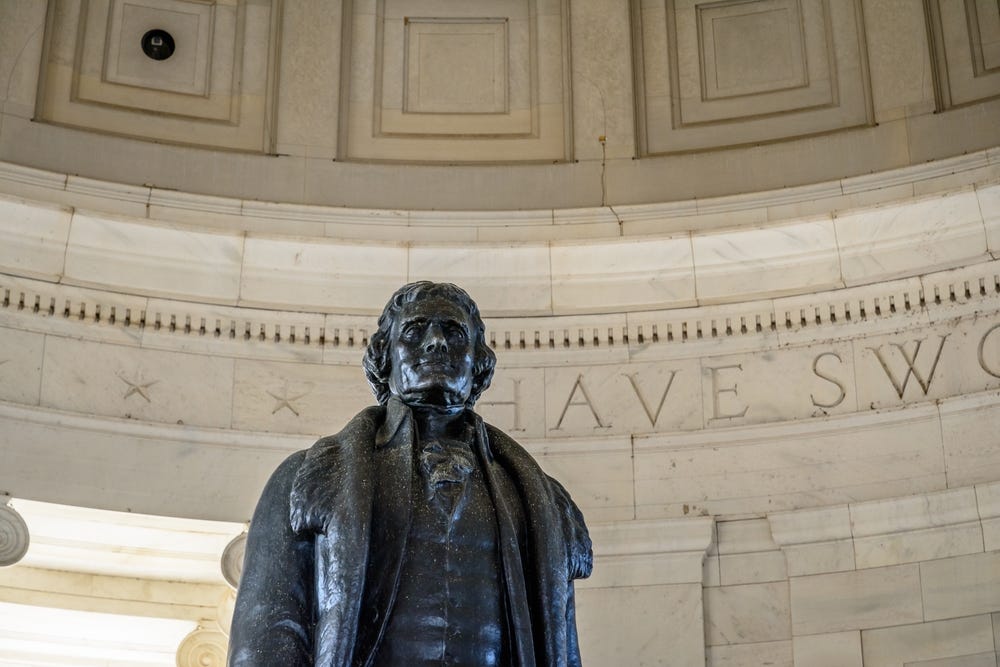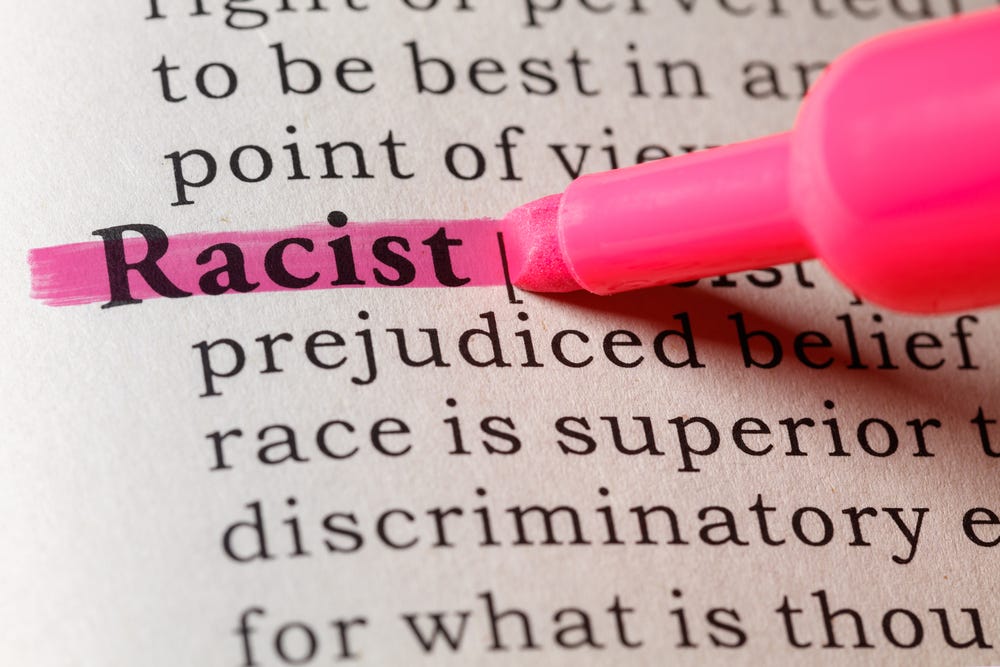E-Pluribus | December 8, 2021
The legacy of Thomas Jefferson, the ever-shifting definition of racism, and how wokeness is affecting classical music.
A round up of the latest and best writing and musings on the rise of illiberalism in the public discourse:
Brian Stewart: What a Free Republic Owes Thomas Jefferson
The removal of a statue of Thomas Jefferson from City Hall in New York City due to his slave-holding past has prompted Brian Stewart at Quillette to reexamine the founder’s legacy and remind readers that, despite the imperfection in character and conduct, Jefferson’s vision (a “promissory note” Martin Luther King Jr. called it) of a freer and more just society is still worthy of honor.
Jefferson was the principal author of the Declaration of Independence, the preamble to which, as Christopher Hitchens put it in his slender biography of the Virginian, “established the concept of human rights, for the first time in history, as the basis for a republic.” This charter of freedom, as Jefferson was careful to insist, captured the broadly shared “common sense of the subject” in the American colonies, the subject being “our rights.” But even if Jefferson meant the Declaration to be an “expression of the American mind,” it required uncommon words to give the first modern nation’s Enlightenment precepts world-historical resonance.
“We hold these truths to be self-evident that all men are created equal, that they are endowed by their Creator with certain unalienable rights, that among these are Life, Liberty and the pursuit of Happiness.” With these imperishable words, Jefferson ensured that a revolutionary “instrument” would be far more than an object of merely national import. This universal emphasis was natural and proper from a man who had, according to Henry Adams, “aspired beyond the ambition of a nationality, and embraced in his view the whole future of man.” Despite his deplorable personal failure to escape the shadow and stain of chattel slavery, Jefferson always exhibited a strong preoccupation with the rights of man evident in his most famous work.
The affirmation of human equality in 1776 was addressed not simply to the British crown or the parliament or even to other Americans, but to “a candid world.” It presented an enlarged conception of natural rights applicable to all men at all times. It has proved the “sheet anchor of American republicanism,” as Abraham Lincoln called it. Put differently, it has provided what America's final founder, Martin Luther King Jr., called a “promissory note” to all Americans. And yet, it also contained the germ of universal liberty that Jefferson hoped might spread to every nation. “May it be to the world what I believe it will be, (to some parts sooner, to others later, but finally to all,) the signal of arousing men to burst the chains … and to assume the blessings and security of self-government.” In any of this, where exactly does one find a belief that some people are “not worthy” of equal natural rights?
For New York City to remove Jefferson’s statue is a travesty that follows the dreadful path of the New York Times’ “1619 Project.” […]
The indiscriminate and frenzied impulse to haul down statues in contemporary America is suggestive. It bespeaks a demand for moral purity from our ancestors—or ourselves, even—before the erection of statues and memorials, but this would be to ask too much of human virtue. In their own time, Elizabeth Cady Stanton and Martin Luther King recognized that the standards of self-government did not require humans to be angels. That would be to make the perfect the enemy of the good. Their arduous struggles would permit admiration of deeply flawed men and women, but not men and women without great virtues or incapable of noble deeds. Those citizens who aspired to virtue and fell short in their personal lives could make precious contributions to the national character if they aspired to greatness in their public lives.
Read it all here.
John McWhorter: How Can Something Be Racist but Not Racist at the Same Time?
Instead of providing a clear path to a more racially tolerant and just society, Ibram X. Kendi’s concept of “anti-racism” and other current ideas related to diversity, equity and inclusion have further muddied the waters. At the New York Times, John McWhorter examines some of the conflicting messages of recent years and how they can amount to a heads-I-win, tails-you-lose proposition for many trying to navigate this fraught issue.
For example, it’s considered a given that diversity on college campuses enhances the educational experience for all students. A 2019 entry on American University’s website says, “A more diverse university community opens all students up to a broader range of perspectives, helping them become better problem solvers and introducing them to new ways of thinking.” […]
But we’re also reminded, at intervals, that students of color sometimes consider it offensive when they’re expected to represent the “diverse” point of view in classes or interactions with their classmates. In 2007, one Harvard Crimson columnist chafed at “Being the token black person,” writing, “I am expected to be an authority on the lives of all black people.” Earlier this year, a PopSugar article surveyed the challenges faced by Black students at predominantly white institutions, or PWIs (the terminological analog to historically Black colleges and universities, or HBCUs), including “a myriad of microaggressions that are exhausting to deal with” and carrying “the burden of representation when it comes to speaking about things from a historical context,” which is “exacerbated when they are the only Black student in their class.”
It can be hard to know where to go on that if diversity is a key component of a well-rounded education but an indefensible burden on the very people representing the diversity.
[…]
These paradoxes make contemporary discussions about race that much harder to sort. Certainly, there have always been different schools of thought on how to address issues of race. Think of the ideological rivalry between W.E.B. Du Bois and Booker T. Washington. Washington stressed education — academic and vocational — and entrepreneurship as keys to Black uplift. Du Bois emphasized political mobilization and a broader condemnation of societal racism. But Washington wasn’t opposed to condemning racism, and Du Bois was hardly opposed to education and entrepreneurship. In any case, in their time, America wasn’t being asked to adopt the notion that the prescriptions of one of these men canceled out those of the other.
There’s something counterproductive about the way contemporary race matters are caveated and couched in questions that so often lead to more questions, rather than to consensus. Often, today’s conversations seem motivated by identifying the element of racism in as many situations as possible. And too many times, this results in Möbius-strip discussions that go nowhere and help no one.
Read it all.
Douglas Murray: Classical Music Without Quotas
Music and art should be an escape from the everyday rancor and division of politics, but instead the arts are being drawn into the same battles over race, sex and equity that have affected many other aspects of society. Douglas Murray makes a plea at National Review to let the music simply be about music lest these classics of culture become themselves victims of a culture war.
In July of last year, the Washington Post insisted that classical music is finally “reckoning with racism.” The New York Times kept its finger equally firmly on the nation’s pulse by writing repeatedly about the alleged racism of classical music and opera. Using a classic and comfortable diversion tactic, such outlets landed especially on the issue of “blind auditions.” This is the process, praised only a few years previously, in which auditionees to major orchestras play from behind a screen so that if there were a grand wizard of the Ku Klux Klan on the selection jury, he could not refuse to hire the performer on the basis of skin color alone. The idea that there is any orchestra board in America in the 2020s that suffers from such a problem is itself a grand delusion. […]
It isn’t just the composition of the orchestras but the schedules themselves that reflect this. Across the U.S. and the U.K., orchestral conductors and others are being forced to establish gender parity not just among players but among composers. A tricky business in itself. Worse is that there is an increasing demand for ever more diverse — i.e., non-white — composers, too. Not that there aren’t any. There have been a number historically, and many of them are happily working today. Still, there is no getting away from the fact that the canon of Western classical music is dominated by men — and men, specifically, who have committed the compounding errors of also having been white and, fatally, of not still being alive today.
A glimpse at the schedules of Carnegie Hall this season reveals the deep unease about what used to be a traditional program. To take an example at random, the current season at Carnegie includes a band whose work, we are told, incorporates “batá drumming, dancing, and singing of Orisha chants that serve to call down and pay tribute to the deities.” I do not wish to single out Carnegie Hall or the particular concert in question. But it is an unavoidable fact that in the schedules of concert halls and opera houses in the Anglosphere one senses a certain chill of fear in the air. Performers who belong to an ethnic minority are being put literally center stage. Billboards focus on the non-white faces to any extent that they can. Anything but living white males playing works by the dreaded dead white ones.
Read the whole thing.
Around Twitter
Jonathan Adler with a disturbing report on ideological corruption of academic scholarship:

Andrew Sullivan with a thought on Dictionary.com’s word of the year, “allyship”:




Via Heterodox Academy, how to stand out from the crowd in graduate school:






Finally, click through for the whole story, but to give you a hint, look at the chair…










